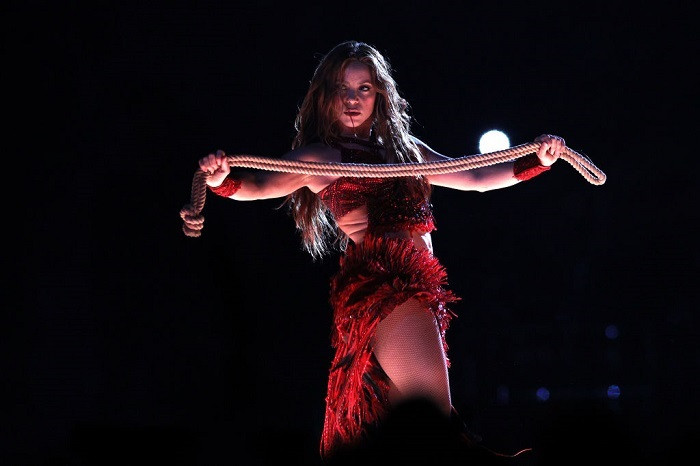Shakira’s Super Bowl LIV Halftime Show performance was more than just a concert; it was a vibrant celebration of culture. While the world was captivated by her energy and hits, many might have missed the rich tapestry of Middle Eastern dance and musical traditions woven into her set. Did you know Shakira is half-Lebanese? This heritage was not just a footnote but a central theme, brought to life through captivating dance moves and musical elements that paid homage to her roots.
 ShakiraSuperBowl54HalfTimeShowPepsi.jpg
ShakiraSuperBowl54HalfTimeShowPepsi.jpg
Shakira’s career has always been a fusion of her Colombian and Lebanese heritage, alongside Spanish and Italian influences. For long-time fans, this blend is familiar, perhaps most explicitly seen in her music video for “Ojos Así.” However, for the Super Bowl, she amplified these Middle Eastern elements, creating a performance that resonated deeply with cultural significance. A viral tweet captured the essence of this, highlighting the profound impact for the Middle Eastern community:
You really have to understand how huge Shakira’s performance was for the Middle Eastern community. She had belly dancing, a mijwiz and a derbeke, performed “Ojos Asi” which was one of the few Shakira songs to have Arabic in it, did a Zaghrouta, all love on the biggest stage
— Danny Hajjar داني Øجار 🇱🇧 (@DanielGHajjar) February 3, 2020
Let’s delve into the specific Middle Eastern dance and musical elements Shakira masterfully incorporated, showcasing not just entertainment but a powerful cultural statement on one of the world’s biggest stages.
The Art of Belly Dance: Strength and Tradition
Belly dance, often misrepresented in Western cultures as merely “sexualized dancing,” carries a much deeper and richer history. This misconception contributes to the Orientalization and exoticization of Middle Eastern women. However, Shakira reclaims this dance form, presenting it as a powerful expression of feminine strength and communal spirit. Her belly dancing segments, often performed solo or surrounded by female dancers, emphasize the demanding physical skill and artistry inherent in this folk dance.
 ShakiraSuperBowl54HalfTimeShowPepsi.jpg
ShakiraSuperBowl54HalfTimeShowPepsi.jpg
Shakira’s command over belly dance is undeniable. The intricate isolations, the fluid torso movements, the percussive hip thrusts – all demonstrate her exceptional skill and years of practice. It’s a demanding dance that requires incredible core strength and body control, a testament to Shakira’s athleticism and dedication to her craft. Her performance transcends mere entertainment; it’s an education in the true artistry of belly dance.
Mijwiz: The Soulful Sound of Arabic Folk Music
The mijwiz, a double-piped reed flute, might be familiar to those who have listened to Middle Eastern music. Often called a “double clarinet,” it’s a staple in Arabic folk music, known for its distinctive and captivating sound. What makes the mijwiz particularly challenging to play is the circular breathing technique it requires, allowing for uninterrupted, continuous melodies.
You could hear the mijwiz prominently during Shakira’s rope dance segment, adding an authentic Middle Eastern flavor to the music. Its inclusion was not just a stylistic choice; it was a deliberate nod to her Lebanese musical heritage, bringing a piece of her ancestry to a global audience. The mijwiz’s lively and rhythmic sound perfectly complemented Shakira’s energetic dance moves, creating a vibrant and culturally rich performance segment.
via GIPHY
A GIF showcasing Shakira’s dynamic rope dance during the Super Bowl Halftime Show, highlighting the mijwiz music accompaniment.
Derbeke: The Rhythmic Heartbeat of the Middle East
Another instrument highlighted in Danny Hajjar’s tweet is the derbeke (or darbuka). This goblet-shaped drum, a modern iteration of the ancient doumbek, boasts a history spanning thousands of years across the Middle East, North Africa, South Asia, and the Mediterranean. Known by various names across regions, it’s called tombak or tonbak in Iran.
During Shakira’s performance of “Empire” before transitioning into Led Zeppelin’s “Kashmir,” you could see a musician playing the derbeke in the orchestral lineup. The drum is played by striking different parts of the drumhead with fingers, producing a range of tones that drive the rhythm of Middle Eastern music. The derbeke provided a powerful percussive foundation to Shakira’s performance, grounding it in traditional Middle Eastern musicality while she seamlessly blended genres.
via GIPHY
A GIF focusing on the derbeke drum being played during Shakira’s Super Bowl performance, emphasizing its rhythmic contribution.
Zaghrouta: The Ululation of Joy and Celebration
Finally, the zaghrouta, a traditional ululation performed by women to express joy and celebration, was a striking element of Shakira’s performance. Despite some misinterpretations online, the zaghrouta is a common and culturally significant sound in Middle Eastern celebrations, from weddings to parties. It’s not limited to Arabic cultures; it’s also prevalent in Iranian celebrations and regions with historical Muslim influence like the Balkans.
Shakira’s use of the zaghrouta was a bold and authentic expression of her heritage. It’s a sound that resonates deeply within Middle Eastern cultures, and its inclusion in the Super Bowl performance served as a powerful moment of cultural pride and representation. It was a clear message: Shakira was celebrating her roots on the world stage, unafraid to showcase her full cultural identity.
via GIPHY
A GIF capturing Shakira performing the zaghrouta during her Super Bowl Halftime Show, showcasing this unique vocal expression.
Shakira’s Dance: A Cultural Bridge
Shakira’s Super Bowl performance was a landmark moment. On a stage watched by over 100 million viewers, she proudly displayed her Lebanese heritage, challenging stereotypes and celebrating Middle Eastern culture in a country often plagued by misinformation. While some complaints about “indecency” inevitably surfaced, it’s clear that for many, the true scandal was Shakira’s unapologetic embrace of her ethnicity.
In conclusion, Shakira’s Super Bowl halftime show was a masterclass in performance and cultural representation. Her dancing wasn’t just entertainment; it was a vibrant expression of her heritage, bringing Middle Eastern dance and music to a global audience. From the intricate moves of belly dance to the soulful sounds of the mijwiz and derbeke, and the celebratory zaghrouta, Shakira’s performance was a powerful and joyous statement of cultural pride. It was a reminder of the richness and diversity of Middle Eastern culture, delivered with the energy and talent only Shakira can provide.
You can watch the full SuperBowl Halftime Show here.

